
If you plan to spend a summer vacation in this region, get ready for its unparalleled Spanish style of enjoying life, late dinners and having fun in open bars and pubs in the most active towns until 2 or 3 AM, if not later. Otherwise you can enjoy a more quite and not less interesting place as well.
Costa Dorada offers a very good balance between beach life and urban activities. With Barcelona and Tarragona at both ends of this coastal region, it takes less that two hours by car from city to city. In escence, you can enjoy the beach during the day, have fun in local places, or simply take a break and go to the city to enjoy a Spanish guitar performance in one of the many architectural icons these cities offer.
In any case you will not regret your decision to visit Costa Dorada because it has something to offer for any taste and style.
![]() Tarragona, A Roman Heritage
Tarragona, A Roman Heritage
The origins of Tarragona are established by the arrival of the first romans to the Iberic penynsula circa 218 b.c. during Escipion's conquests campaigns. 'Tarraco' (as the city was originally named), became the first settlement out of Italy and the great mediterranean islands by the Roman Empire.
Since Roman times, we can see one of the most oustanding monuments incredibly well preserved today, the city walls. It was a magnificent city , to the point that Augustus himself lived here for over two years.
With its own identity and personality during these historic years, Tarragona became the headquarters for the metropolitan bishops until its assimilation to the Andalucian's domains in 714 a.c.
Tarragona survived wars and battles of all kinds during sXVII and sXVIII, epidemics and pirate attacks. Definitively we cannot put the long history of Tarragona in less than 100 words, but it just takes a visit to live it through its traditions and beautifully preserved architecture to magically transport ourselves back in time...
One Day Itinerary to Change Scenery (Update 2010)
In Costa Dorada you certainly will find the best beaches in Western Europe. Wide, open, extensive, and for all kinds of tastes and lifestyles. But Catalonia is diverse in its terrain and possibilities. If you like to take advantage of typical short distance day trips, (particularly for us used to drive miles instead of kilometers), you can put yourself in a complete different scenery. Drive a few miles (kilometers) away from the coast into the high mountains to the "Alt Camps of Penedes", the highlands of Catalunya.
In our case, and following our Cousin Jordi's suggestions, we went for the following one day trip near Tarragona. Below you will find the itinerary we chose for that typical Sunday getaway for Catalonians.
View Larger Map
We started in ![]() El Veldrell, driving on the N340 West (
El Veldrell, driving on the N340 West (![]() Tarragona direction). We continued our journey in direction to Reus. Our goal was to reach the T-704 road. The scenery and the zig-zagging course of this road is quite amusing if you like vineyards, olive fields and mountains all combined.
Tarragona direction). We continued our journey in direction to Reus. Our goal was to reach the T-704 road. The scenery and the zig-zagging course of this road is quite amusing if you like vineyards, olive fields and mountains all combined.
![]() La Mussara: Our first stop in this loop was this uninhabited town. Looking at an abbandoned town is a very strange feeling. You look at what remains of family homes, a church in ruins covered by vegetagion and it feeds the imagination about how life had been there before. There is an interesting number of abbandoned towns in Catalonia, as well in the rest of Spain. Those towns were victims of development and outside opportunities that had pulled the younger generations to other lands or big cities. In the past few years this trend started to reverse by young couples who had claimed the land, paid due taxes to the government to rebuild and bring towns back to life. Certainly it is a phenomenon that is counting a diverse number of cases in the country already.
La Mussara: Our first stop in this loop was this uninhabited town. Looking at an abbandoned town is a very strange feeling. You look at what remains of family homes, a church in ruins covered by vegetagion and it feeds the imagination about how life had been there before. There is an interesting number of abbandoned towns in Catalonia, as well in the rest of Spain. Those towns were victims of development and outside opportunities that had pulled the younger generations to other lands or big cities. In the past few years this trend started to reverse by young couples who had claimed the land, paid due taxes to the government to rebuild and bring towns back to life. Certainly it is a phenomenon that is counting a diverse number of cases in the country already.
![]() Prades: From La Mussara we continued on the same route to Prades. This town that originated with the Moorish also preserves ruins from the Neolithic period. It was originally sourrounded by fortification walls that you can still see at the town's gate close to the Plaça Major. One of the most beautiful architectures is the "Santa María La Major" Church. This is a perfect spot to stop and have your favorite drink before continuing the circuit.
Prades: From La Mussara we continued on the same route to Prades. This town that originated with the Moorish also preserves ruins from the Neolithic period. It was originally sourrounded by fortification walls that you can still see at the town's gate close to the Plaça Major. One of the most beautiful architectures is the "Santa María La Major" Church. This is a perfect spot to stop and have your favorite drink before continuing the circuit.
![]() Poblet Monastery: As we headed to Poblet, we visited the Monastery which takes its name from the town. "Monestir de Poblet", which is part of the Cister Order along with Montes Creus (shown earlier in this page) and others accross the region. You can visit the monastery and also the winery where you can taste local wines produced by the monks. We advise you to check the hours of operation before you go as they tend to change each season.
Poblet Monastery: As we headed to Poblet, we visited the Monastery which takes its name from the town. "Monestir de Poblet", which is part of the Cister Order along with Montes Creus (shown earlier in this page) and others accross the region. You can visit the monastery and also the winery where you can taste local wines produced by the monks. We advise you to check the hours of operation before you go as they tend to change each season.
![]() Montblanc: Here we found a well maintained walled town, perhaps the best presereved in the whole Catalonia. Its medieval bildings, towers and walls are still the content of a tranquil town. For its size it has a very nice variety of restaurants and petit hotels. It is a point of interest for Catalonians on their weekend getaways.
Montblanc: Here we found a well maintained walled town, perhaps the best presereved in the whole Catalonia. Its medieval bildings, towers and walls are still the content of a tranquil town. For its size it has a very nice variety of restaurants and petit hotels. It is a point of interest for Catalonians on their weekend getaways.
![]() Siurana: The access to this little and beautiful town is a zig-zagged road filled with incredible views. At the top end of the road emerges this town, that takes its name from the Siurana River. It was the last Moorish fortress circa 1150ac. It's strategic geographical location gave birth to this little town that keeps the phisonomy of the original architectur, despite the remodeling done through the centuries. Do not miss this town and its great view points!.
Siurana: The access to this little and beautiful town is a zig-zagged road filled with incredible views. At the top end of the road emerges this town, that takes its name from the Siurana River. It was the last Moorish fortress circa 1150ac. It's strategic geographical location gave birth to this little town that keeps the phisonomy of the original architectur, despite the remodeling done through the centuries. Do not miss this town and its great view points!.
![]() La Roc de Sant Gaietá: As the last stop of this one-day loop and reaching the evening we arrived to this beautiful waterfront true mediterranean style town. Full of passages, arches and Moorish outlines. This place is full of restaurants and proud to offer the fresh produce of the sea. We can say that from the whole loop completed that day, this stop was the one we personally enjoyed the most. Another jewell of the Costa Daurada
La Roc de Sant Gaietá: As the last stop of this one-day loop and reaching the evening we arrived to this beautiful waterfront true mediterranean style town. Full of passages, arches and Moorish outlines. This place is full of restaurants and proud to offer the fresh produce of the sea. We can say that from the whole loop completed that day, this stop was the one we personally enjoyed the most. Another jewell of the Costa Daurada
Barcelona
Catalonia offers an inmense number of options that we did not cover in our trips. Of course its major atraction is Barcelona. A cosmopolitan but yet authentic and traditional town gives the classy touch to a beautiful region with great traditions and culture that makes all Catalonians proud.
Nothing more opposite to the AgroToursim like Barcelona. Yet, we cannot conclude this chapter without making a reference to this city. For that reason, here is a video we composed in our first trip to Catalonia back in 2001. Perhaps this trip planted the seed in our minds to start sharing these experiences with you a few years later. We hope you enjoy it!

Originated by the colonization of monks and sisters followers of St. Benedict's doctrine, monasteries like Santes Creus (shown in this page), along with Poblet and Vallbona, are a collection of incredibly well preserved monasteries built between 1100 and 1200's.
If you are driving in the area, we suggest you visit them to be amazed by these architectural jewells, enjoy the scenery of the rural roads and have a taste of their produce in the meantime.
We recommend you spend half a day in any of these locations.
More Information? Visit this link



